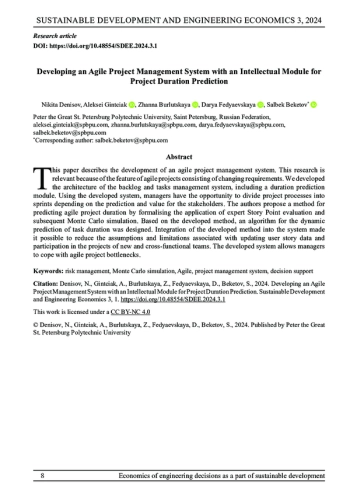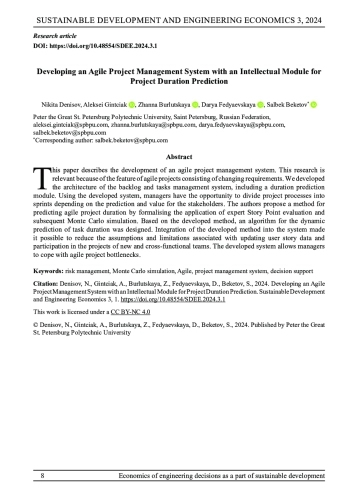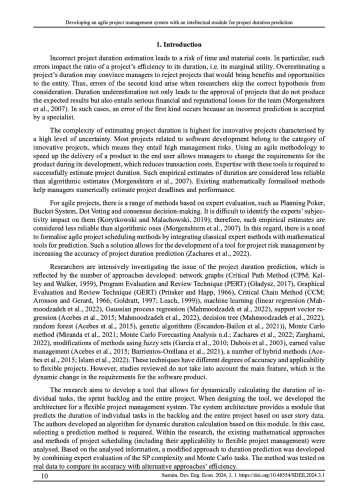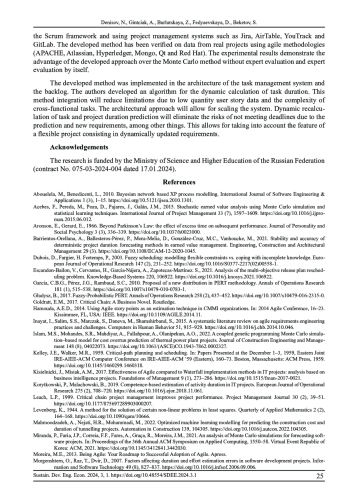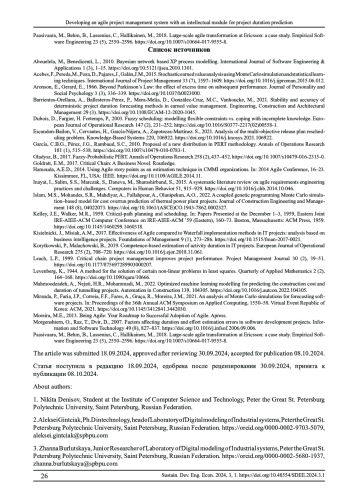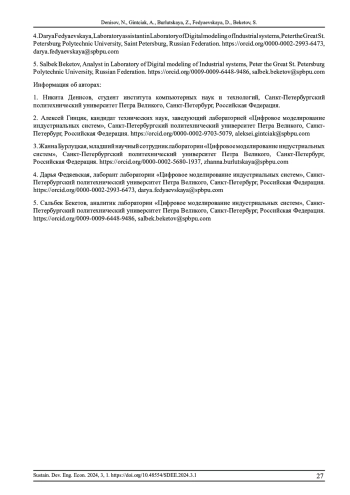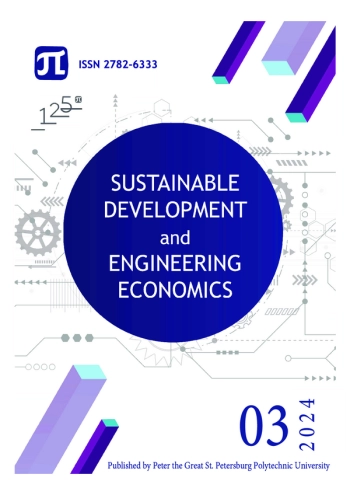This paper describes the development of an agile project management system. This research is relevant because of the feature of agile projects consisting of changing requirements. We developed the architecture of the backlog and tasks management system, including a duration prediction module. Using the developed system, managers have the opportunity to divide project processes into sprints depending on the prediction and value for the stakeholders. The authors propose a method for predicting agile project duration by formalising the application of expert Story Point evaluation and subsequent Monte Carlo simulation. Based on the developed method, an algorithm for the dynamic prediction of task duration was designed. Integration of the developed method into the system made it possible to reduce the assumptions and limitations associated with updating user story data and participation in the projects of new and cross-functional teams. The developed system allows managers to cope with agile project bottlenecks.
Идентификаторы и классификаторы
Incorrect project duration estimation leads to a risk of time and material costs. In particular, such errors impact the ratio of a project’s efficiency to its duration, i. e. its marginal utility. Overestimating a project’s duration may convince managers to reject projects that would bring benefits and opportunities to the entity. Thus, errors of the second kind arise when researchers skip the correct hypothesis from consideration. Duration underestimation not only leads to the approval of projects that do not produce the expected results but also entails serious financial and reputational losses for the team (Morgenshtern et al., 2007). In such cases, an error of the first kind occurs because an incorrect prediction is accepted by a specialist.
Список литературы
1. Abouelela, M., Benedicenti, L., 2010. Bayesian network based XP process modelling. International Journal of Software Engineering & Applications 1 (3), 1-15. DOI: 10.5121/ijsea.2010.1301
2. Acebes, F., Pereda, M., Poza, D., Pajares, J., Galán, J.M., 2015. Stochastic earned value analysis using Monte Carlo simulation and statistical learning techniques. International Journal of Project Management 33 (7), 1597-1609. DOI: 10.1016/j.ijproman.2015.06.012 EDN: XOVBKP
3. Aronson, E., Gerard, E., 1966. Beyond Parkinson’s Law: the effect of excess time on subsequent performance. Journal of Personality and Social Psychology 3 (3), 336-339. DOI: 10.1037/h0023000
4. Barrientos-Orellana, A., Ballesteros-Pérez, P., Mora-Melia, D., González-Cruz, M.C., Vanhoucke, M., 2021. Stability and accuracy of deterministic project duration forecasting methods in earned value management. Engineering, Construction and Architectural Management 29 (3). DOI: 10.1108/ECAM-12-2020-1045 EDN: LHKHKC
5. Dubois, D., Fargier, H. Fortemps, P., 2003. Fuzzy scheduling: modelling flexible constraints vs. coping with incomplete knowledge. European Journal of Operational Research 147 (2), 231-252. DOI: 10.1016/S0377-2217(02)00558-1
6. Escandon-Bailon, V., Cervantes, H., García-Nájera, A., Zapotecas-Martínez. S., 2021. Analysis of the multi-objective release plan rescheduling problem. Knowledge-Based Systems 220, 106922. DOI: 10.1016/j.knosys.2021.106922 EDN: AHUATO
7. García, C.B.G., Pérez, J.G., Rambaud, S.C., 2010. Proposal of a new distribution in PERT methodology. Annals of Operations Research 181 (1), 515-538. DOI: 10.1007/s10479-010-0783-1 EDN: ZCAAGY
8. Gładysz, B., 2017. Fuzzy-Probabilistic PERT. Annals of Operations Research 258 (2), 437-452. DOI: 10.1007/s10479-016-2315-0 EDN: FMEMEL
9. Goldratt, E.M., 2017. Critical Chain: A Business Novel. Routledge.
10. Hamouda, A.E.D., 2014. Using Agile story points as an estimation technique in CMMI organizations. In: 2014 Agile Conference, 16-23. Kissimmee, FL, USA: IEEE. DOI: 10.1109/AGILE.2014.11
11. Inayat, I., Salim, S.S., Marczak, S., Daneva, M., Shamshirband, S., 2015. A systematic literature review on agile requirements engineering practices and challenges. Computers in Human Behavior 51, 915-929. DOI: 10.1016/j.chb.2014.10.046
12. Islam, M.S., Mohandes, S.R., Mahdiyar, A., Fallahpour, A., Olanipekun, A.O., 2022. A coupled genetic programming Monte Carlo simulation-based model for cost overrun prediction of thermal power plant projects. Journal of Construction Engineering and Management 148 (8), 04022073. DOI: 10.1061/(ASCE)CO.1943-7862.0002327
13. Kelley, J.E., Walker, M.R., 1959. Critical-path planning and scheduling. In: Papers Presented at the December 1-3, 1959, Eastern Joint IRE-AIEE-ACM Computer Conference on IRE-AIEE-ACM ’59 (Eastern), 160-73. Boston, Massachusetts: ACM Press, 1959. DOI: 10.1145/1460299.1460318
14. Kisielnicki, J., Misiak, A.M., 2017. Effectiveness of Agile compared to Waterfall implementation methods in IT projects: analysis based on business intelligence projects. Foundations of Management 9 (1), 273-286. DOI: 10.1515/fman-2017-0021
15. Korytkowski, P., Malachowski, B., 2019. Competence-based estimation of activity duration in IT projects. European Journal of Operational Research 275 (2), 708-720. DOI: 10.1016/j.ejor.2018.11.061
16. Leach, L.P., 1999. Critical chain project management improves project performance. Project Management Journal 30 (2), 39-51. DOI: 10.1177/875697289903000207
17. Levenberg, K., 1944. A method for the solution of certain non-linear problems in least squares. Quarterly of Applied Mathematics 2 (2), 164-168. DOI: 10.1090/qam/10666
18. Mahmoodzadeh, A., Nejati, H.R., Mohammadi, M., 2022. Optimized machine learning modelling for predicting the construction cost and duration of tunnelling projects. Automation in Construction 139, 104305. DOI: 10.1016/j.autcon.2022.104305 EDN: UTCHOI
19. Miranda, P., Faria, J.P., Correia, F.F., Fares, A., Graça, R., Moreira, J.M., 2021. An analysis of Monte Carlo simulations for forecasting software projects. In: Proceedings of the 36th Annual ACM Symposium on Applied Computing, 1550-58. Virtual Event Republic of Korea: ACM, 2021. DOI: 10.1145/3412841.3442030
20. Moreira, M.E., 2013. Being Agile: Your Roadmap to Successful Adoption of Agile. Apress.
21. Morgenshtern, O., Raz, T., Dvir, D., 2007. Factors affecting duration and effort estimation errors in software development projects. Information and Software Technology 49 (8), 827-837. DOI: 10.1016/j.infsof.2006.09.006
22. Paasivaara, M., Behm, B., Lassenius, C., Hallikainen, M., 2018. Large-scale agile transformation at Ericsson: a case study. Empirical Software Engineering 23 (5), 2550-2596. DOI: 10.1007/s10664-017-9555-8 EDN: YEIDML
Выпуск
Другие статьи выпуска
The present paper develops an invariant ontology of strategic interaction in a sociotechnical system using game theory tools. In the course of the research, ontologies are considered tools for modelling sociotechnical systems, including tools for social and technical process integration. The demand for these tools derives from the need to integrate people into technical systems as equivalent and equal elements that exert both external and internal influence on the system. Such sociotechnical models have already been applied to describe enterprise information structures, but they lack a description of decision-making between the system elements within the strategic inter-action. As part of the solution to this problem, an ontology-based model of a sociotechnical system describing the interaction of both social and technical elements through game interaction is developed. Each of the participants in the interaction is described in terms of game theory, with the allocation of possible strategies and the corre-sponding winnings. Through the interactive entities within the game theory model, game interaction takes place between the participant and appropriate behaviour strategy selection. The model is a exible, scalable tool for building simulation models of sociotechnical systems. The results obtained will be tested when real sociotechnical systems are built, and the ontology will be re ned according to the results obtained.
Today, in order to develop national economies, it is necessary to pay attention to the economies of the regions of the countries. The regional economy is the basis of the national welfare. In the Russian Federation there are a number of problems with regional development, one of which is the differentiated development of the constituent entities of the Russian Federation. Every year, the difference in development increases due to the rapid growth of large economic regions and the lag in regions removed from the central regions. In the context of such key competition factors, this development becomes competitive in the region. The article examines various concepts of and approaches to regional competitiveness that contribute to the formation of comprehensive economic cooperation. Through analysis of statistics on indicators of the socio-economic development of some regions of the Russian Federation, the reason for the observed disproportion was identified. This reason is the outflow of population. A person with strength and skills is a key part of building a regional economic system. To solve problems that arise in the work, a model for increasing regional competitiveness is proposed, which includes three stages. The first is basic, focusing on building the foundations of production; the second stage involves focusing on the development of science and education; and the third is creative, focused on the development of creative industries. Thus, the model proposed by the author meets the criterion of complexity, as well as the requirements for increasing the competitiveness of regions in the medium and long term, which will contribute to the socio-economic development of the constituent entities of the Russian Federation, balance and balance in the level of development of the country as a whole.
This article considers entropy analysis as a tool for assessing the sustainability and integration of regional economies into national and international economic systems. Three key types of entropy are de ned - economic diversi cation, income and employment distribution and interregional ties. The methodology for calculating entropy indicators based on the generalised Shannon entropy formula is presented. A comparative analysis of three hypothetical regions was conducted on the basis of entropy indices. The obtained results allow us to quantitatively assess the speci cs of regional development, identify imbalances and propose strategies to improve the sustainability and economic diversi cation of regions.
This article focuses on improving the information security of industrial enterprises through the automation of data transmission processes. As a solution, an autonomous unmanned aerial vehicle (UAV) equipped with three microcontrollers is proposed to handle ight control, data processing and transmission and information protection. The system utilises infrared data transmission channels, hardware encryption and a mechanism for the physical destruction of the storage medium, ensuring a high level of protection against cyberattacks and data breaches. The drone’s architecture is isolated from corporate networks and features mobility and autonomy, making it e ective in environments with limited infrastructure. The modular design of the device allows for adaptation to various application scenarios. The research results demonstrate that the proposed solution provides reliable and secure data transmission, enhancing the resilience of enterprises to modern cyber threats.
Статистика статьи
Статистика просмотров за 2025 год.
Издательство
- Издательство
- Политех
- Регион
- Россия, Санкт-Петербург
- Почтовый адрес
- 195251, г.Санкт-Петербург, ул. Политехническая, дом 29
- Юр. адрес
- 195251, г Санкт-Петербург, Калининский р-н, ул Политехническая, д 29 литера б
- ФИО
- Рудской Андрей Иванович (РЕКТОР)
- E-mail адрес
- office@spbstu.ru
- Контактный телефон
- +7 (812) 2972077
- Сайт
- https://spbstu.ru
